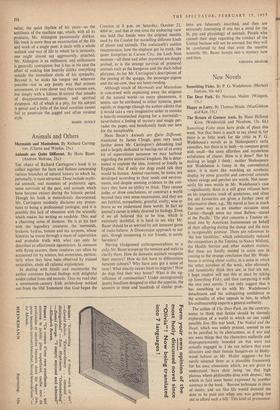Animals and Others
Mermaids and Mastodons. By Richard Carring- ton. (Chatto and Windus, 25s.) Animals are Quite Different. By Hans Bauer. (Andrew Melrose, 21s.) THE object of Richard Carrington's book is to collect together the facts and fictions concerning various branches of natural history to which he, personally, is most attracted. These include mythi- cal animals, real monsters of prehistoric ages, some survivals of the past, and animals which have become extinct during the historic period. Though his book is meticulously documented, Mr. Carrington modestly disclaims any preten- tions to being a professional zoologist, and it is possibly this lack of obsession with the scientific which makes his writing so readable. This, and a charming sense of humour. He is at his best with the legendary creatures, the mermaids, krakens, hydras, bonzes and sea serpents, whose histories he traces through a maze of superstition and probable truth with what can only be described as affectionate agnosticism. In common with flying saucers, these creatures can often be accounted for by science, but sometimes, particu- larly when they have been observed by trained naturalists, elude all rational explanation.
In dealing with fossils and mammoths the author combines factual findings with delightful asides culled from old records. Thus we read that a seventeenth-century Irish archbishop worked out from the Old Testament that God began the
Creation at 8 p.m. on Saturday, October 22, 4004 BC; and that at one time the endearing view was held that fossils were the original moulds used by the Creator for modelling different kinds of plants and animals. The coelacanth's sudden reappearance, how the elephant got its trunk, the queer footprints at Carson City, the Loch Ness monster—all these and other mysteries are deeply probed, as is the strange survival of primaeval animals such as the kangaroo and the duck-billed platypus. As for Mr. Carrington's descriptions of the passing of the quagga, the passenger-pigeon and the sea-cow, they are heart-rending.
Although much of Mermaids and Mastodons is concerned with explaining away the enigmas of the natural world—so many phenomena, it seems, can be attributed to either hysteria, giant squids, or dugongs (though the author admits that it would take a very imaginative sailor to mistake a .heavily-moustached dugong for a mermaid)— nevertheless a feeling of mystery and magic per- vades the pages, and beneficently feeds our love for the inexplicable.
Hans Bauer's Animals are Quite Different, translated by James Cleugh, goes very much farther down Mr. Carrington's debunking trail and is largely dedicated to beating out of us every bit of superstitious animal we may harbour regarding the entire animal kingdom. He is deter- mined to explode the idea, fostered so fondly in England, that if only our dogs could talk they would be human. Animal reactions, he states, are developed according to their needs and environ- ments, and despite seeming evidence to the con- trary they have no ability to think. They cannot judge, or draw conclusions, or construct a world beyond their own sense-impressions, and they are not faithful, sympathetic, grateful, crafty, wise or brave as we understand these words. In fact an animal's career is solely directed by biology. Even if we all believed this to be true, which is extremely doubtful, it is hard to see why Mr. Batter should be so worried by our innocent game of make-believe. A Disneyesque approach to our pets, though nauseating to our friends, is surely harmless?
Having bludgeoned anthropomorphism to a pulp, Mr. Bauer scoops up the remains and seeks to clarify them. How do domestic animals recognise their masters? How do fish learn to differentiate between colours? Why have ants got a sense of time? What exactly causes birds to migrate? How do dogs find their way home? What is the sig- nificance of communities? Under. .incongruously jaunty headlines designed-to whet the appetite, the answers to these and hundreds of similar prob- lems are fulsomely inscribed, and they are extremely interesting if one has a mind for the bi, psy and physiology of animals, People who consult their dogs regarding the conduct of the United Nations will not be amused, but they will be comforted to find that even the sensible scientific Mr. Bauer bumps into a mystery now and then.
VIRGINIA GRAHAM


































 Previous page
Previous page